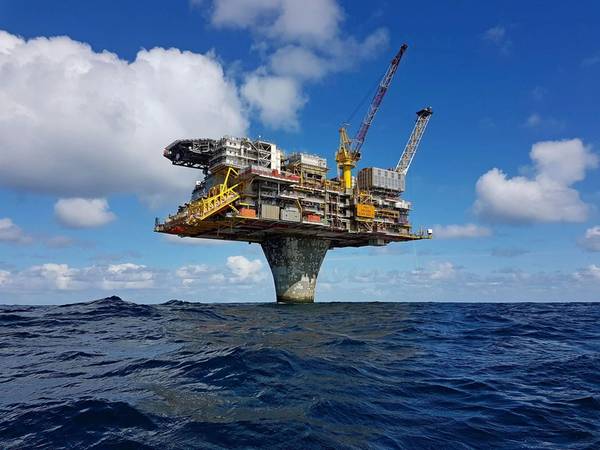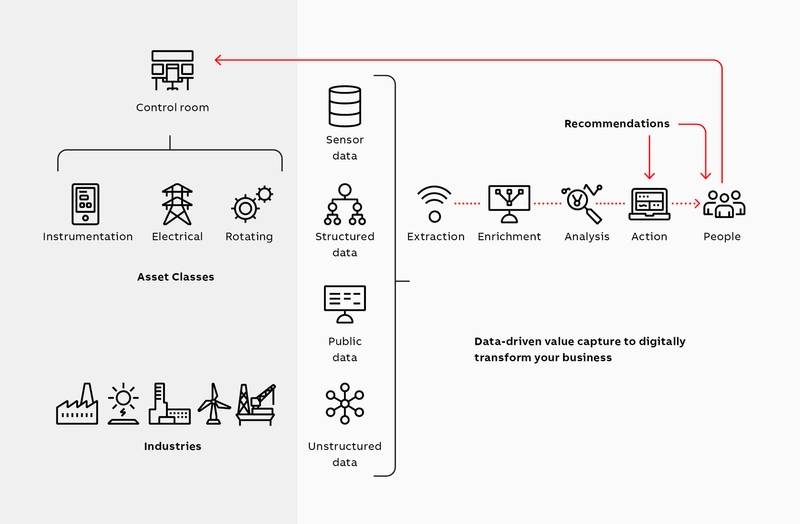
Ryan Conger, Technical Sales Manager for APM at ABB Energy Industries, explains how reactive asset performance management (APM) has evolved into APM 4.0, and why partnering with a trusted technology provider can help oil and gas operators avoid costly downtime and maximize profitability.
Over the past two decades, asset performance management (APM) has been transformed from a routine concern to front and center in the process industries, turbocharged by digital innovations such as artificial intelligence (AI), the industrial internet of things and predictive data analytics.
Digitalization and automation solutions that extract and analyze OT, IT and ET data are empowering sectors such as oil and gas to get ahead of and own conditioning monitoring of their critical assets, rather than reacting when machinery or equipment fails, resulting in costly production downtime.
This remarkable evolution from ‘run-to-failure’ or reactive APM to today’s high-end quantitative risk analysis and current state of machine health solutions – often referred to as ‘APM 4.0’ – is a boon for resource-heavy extractive industries like oil and gas, which now, more than ever, need to ensure they leverage the vast amounts of data available to them to maximize production and profitability, reduce downtime, energy consumption and carbon emissions, and maintain competitive advantage.
APM, when deployed cost-effectively in partnership with a trusted technology vendor like ABB, can help offshore operators establish a solid reliability culture by providing insights into asset health, and recommending proactive measures that predict and avert failures1, driving genuine business value.
In this article, we will focus on key trends in APM 4.0 and explain how a layered approach to can help demystify technology and help customers identify the correct solution based on their operational and risk profile, as well as take a look at ABB’s ground-breaking project with Norwegian oil and gas operator OKEA to live-stream process data from their offshore platform to the cloud enabling remote monitoring of asset health.
A Layered Approach to APM
There are many buzzwords in the APM ecosystem, yet the ultimate goal is simple: to predict process upsets in real time, fix small problems before they become large, and avoid unplanned breakdowns, ensuring that industrial assets operate at their optimum performance and productivity levels, while at the same time minimizing operational risks and maintenance costs2.
When we talk about APM 4.0, it all starts with an initiating event – the process upset, the degradation of the asset, the failure of upstream or supporting equipment – which allows us to create layers of protection around that asset to avoid further failure. This first layer of protection is what we call rules-based monitoring: this may be a single sensor that sends an alert if the temperature or pressure exceeds a pre-defined threshold, or a more complicated if-then statement using multiple sensors.
An example of a derived or calculated monitor is taking raw vibration data and evaluating the spectral signature of that vibration. We know that if vibration is increasing, it’s worth investigating the cause. Based on the signature in the frequency domain, we can infer the likely cause. Other than interference or rub, vibration issues don’t fix themselves. So that's one layer of protection, let’s call it the baseline layer, and customers can get significant value out of that form of APM. Image courtesy ABB Energy Industries
Image courtesy ABB Energy Industries
However, there are additional layers that ABB can deploy to maximize protection around the asset, and, typically, the more advanced the layer is, the more lead time the customer will get in terms of predicting when something is going poorly. Using a medical analogy, the APM solution is alerting the operator to the fact that the calcification of their arteries exists three years ahead of the heart attack. Better yet, a layered approach can identify elevated cholesterol decades in advance so the risk can be mitigated before significant damage occurs.
This more sophisticated layer works around ‘first principles’ models. ‘First principles’ models are based on the engineering design and physics behind the way a piece of equipment operates. We create physics-based models that tell us from a performance perspective how something should operate, which can be rolled out quickly across similar asset types. By comparing actual performance versus theoretical, degradation or sub-optimal operation can be quickly spotted.
Hybrid versus time-based models
The final layer utilizes data-driven and statistical models, also referred to as AI and machine-learning (ML) models. We teach algorithms what good asset performance looks like across the different variables. It then alerts the operator if and when the asset deviates from these conditions. Based on the variables that have deviated from past good behaviour, we propose the failure mode that is most likely to occur.
A key differentiator of this type of model is that it can be deployed on any asset type or system (rotating, electrical and fixed equipment) that can provide adequate levels of sensor data. When we combine both ‘first principles’ and data-driven model, we create a hybrid modelling approach to provide maximum protection for the most critical assets. Depending on the criticality of the asset and their specific risk profile, the customer can decide how many layers they want to put in place. Low-cost assets that are easy to replace may be run to failure (reactive), whereas it makes sound business sense to secure more critical assets – where downtime and maintenance costs may run to millions of dollars – with data-driven APM.
Maintaining assets only when needed has been shown to decrease maintenance costs by 20–30% and doing so efficiently reduces downtime by 20–50%. Unplanned maintenance is 4–10 times more expensive.
It is also important to note that only 18% of asset failures happen due to wear and tear3, meaning that time or usage-based maintenance is the wrong strategy to use at least 80% of the time.
Pushing the boundaries: ABB and OKEA
Earlier, I mentioned that partnering with a technology provider with deep domain knowledge of APM and its role in the process industries is a prerequisite for success. This is vividly illustrated by ABB’s digital partnership with Norwegian operator OKEA, which resulted in the Norwegian operator becoming the first oil and gas company to successfully live-stream contextualized process data to the cloud.
Located 130km from shore, Draugen is one of Norway’s largest oil fields. Streaming real-time data directly from the control system to the cloud was a major achievement. The time it takes for the high-resolution data including structure, objects, and alarms and events to be generated to being available in the cloud is just 0.8 seconds. Using ABB’s portfolio of digital solutions including Asset Performance Management applications and services, OKEA is able remotely monitor asset health in near real-time. This project achieved distributed asset data updates securely, enabling personnel to visualize, analyze, and predict operations more efficiently for more informed, data-driven decision-making, and cost savings of as much as 30%5. In addition, less personnel were required on the platform to monitor equipment. This enabled safer operations without increased risk.
Projects such as this demonstrate the power of streaming solutions such as 'Software-as-a-service' (SAAS), and how APM 4.0 – incorporating innovations such as AI and ML, combined with creative problem-solving, expertise and collaboration6 – can help unlock the disruptive power of APM 4.0. About the Author: Ryan Conger is the Technical Sales Manager for APM at ABB Energy Industries. Image courtesy ABB Energy Industries
About the Author: Ryan Conger is the Technical Sales Manager for APM at ABB Energy Industries. Image courtesy ABB Energy Industries
Sources:
1,2 https://new.abb.com/process-automation/genix/genix-apm
3 What is Asset Performance Management (APM)? | ARC Advisory Group (arcweb.com)
5,6 https://new.abb.com/oil-and-gas/digital/okea-digital-partnership (video and text)